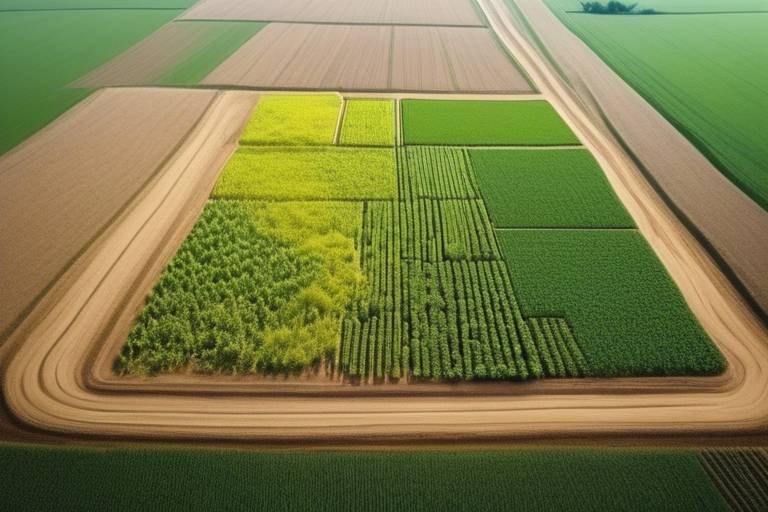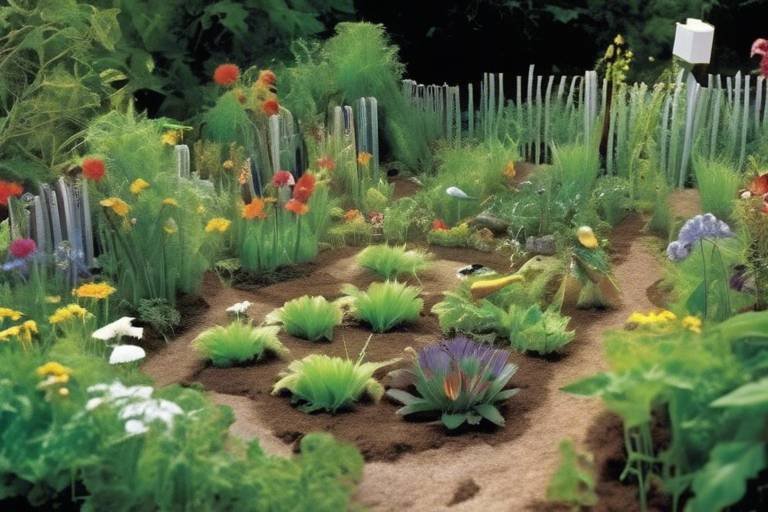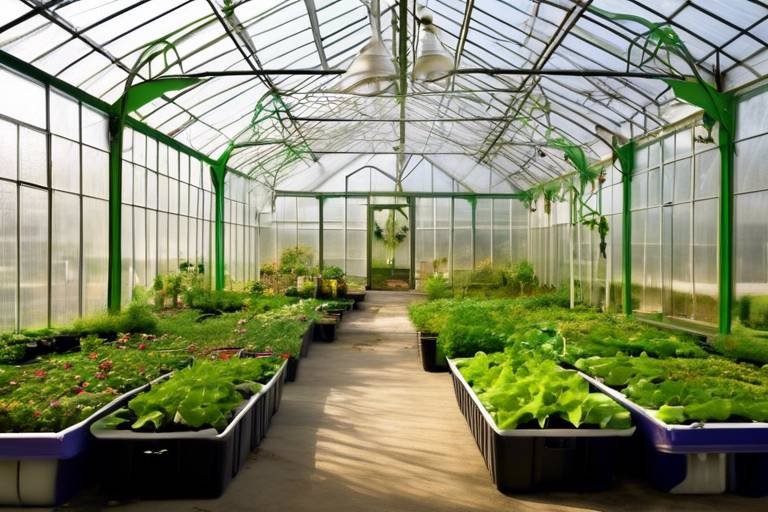How to Choose the Best Eco-Friendly Gardening Tools?
Choosing the right gardening tools can feel like navigating a jungle of options, especially when you're committed to being environmentally conscious. With the growing awareness of our planet's needs, it's essential to select tools that not only help you cultivate your garden but also protect the environment. So, how do you sift through the multitude of choices and find the perfect eco-friendly gardening tools? Let’s dig deep into the factors that matter!
First off, let’s talk about materials. Eco-friendly gardening tools come in a variety of materials that are kinder to our planet. Think of bamboo—this fast-growing grass is not only durable but also renewable. When you use bamboo tools, you're opting for a sustainable resource that grows back quickly after harvesting. Another material gaining popularity is recycled plastics. These tools help reduce waste by repurposing materials that would otherwise end up in landfills. Lastly, consider biodegradable options. These tools break down over time, leaving no trace behind, which is a win-win for your garden and the environment!
Now that we've covered materials, let’s explore the benefits of using sustainable gardening tools. One of the most significant advantages is the reduced environmental impact. By choosing eco-friendly options, you’re not only lessening your carbon footprint but also promoting a greener lifestyle. These tools tend to be made with durability in mind, meaning they last longer than traditional tools, which often break or wear out quickly. This longevity translates into fewer replacements and, ultimately, a smaller ecological footprint. But wait, there's more! Using sustainable tools can also enhance your gardening experience, making it more enjoyable and fulfilling.
Speaking of durability, let’s dive deeper into why it matters. When you invest in quality eco-friendly tools, you’re not just spending money; you’re making a wise financial decision. Imagine buying a tool that lasts for years instead of one that needs replacing every season. It’s like choosing a sturdy pair of shoes over cheap flip-flops—one will serve you well, while the other might leave you stranded! So, by selecting tools designed to endure the test of time, you’re saving money and reducing waste, which is a double win in the world of eco-gardening.
To keep your eco-friendly tools in top shape, maintenance is key. Here are some essential tips:
- Clean after use: Dirt and debris can cause rust and degradation, so give your tools a good rinse and dry them thoroughly.
- Store properly: Keep your tools in a dry place to prevent moisture damage. A well-organized shed can do wonders!
- Sharpen blades: Dull tools are not only frustrating but can also lead to injury. Regularly sharpen your tools to keep them effective.
In a throwaway culture, it’s easy to default to replacing broken tools. However, embracing a mindset of repairing rather than replacing is crucial for sustainability. Many tools can be fixed with a little effort, saving you money and resources. Think of it this way: instead of tossing away a broken shovel, why not try to fix it? You’ll not only save money but also contribute to a culture of resourcefulness and environmental stewardship.
Let’s talk dollars and cents. Initially, eco-friendly gardening tools may seem pricier than their traditional counterparts, but consider this: investing in quality means fewer replacements and less waste. Over time, this can lead to significant savings. Plus, think about the health benefits of using non-toxic tools that don’t leach harmful chemicals into your garden soil. Your plants, and ultimately your health, will thank you!
When choosing your gardening tools, it’s also essential to consider the brands behind them. Look for companies that prioritize sustainability in their business practices. This includes ethical sourcing of materials, environmentally friendly manufacturing processes, and a commitment to reducing their carbon footprint. By supporting brands that align with your values, you’re not just buying a tool; you’re investing in a greener future.
To help you make informed choices, familiarize yourself with various certifications and eco-labels. These labels indicate a product's environmental friendliness and can guide your purchasing decisions. Look for certifications like FSC (Forest Stewardship Council) for wooden tools or Cradle to Cradle for products designed with sustainability in mind. Knowing what these labels mean can empower you to choose wisely!
Finally, don’t overlook the benefits of supporting local businesses and community initiatives. Not only does this help boost the local economy, but it also reduces carbon footprints associated with shipping products over long distances. Plus, local businesses often have unique, eco-friendly options that you won’t find in big-box stores. It’s a great way to connect with your community while making sustainable choices!
Q: Are eco-friendly gardening tools more expensive?
A: Initially, they may seem pricier, but their durability often leads to long-term savings.
Q: How can I tell if a gardening tool is eco-friendly?
A: Look for certifications, materials used, and the brand’s sustainability practices.
Q: Can I repair my gardening tools?
A: Yes! Many tools can be repaired with a little effort, promoting sustainability.
Q: What materials should I look for in eco-friendly tools?
A: Opt for bamboo, recycled plastics, and biodegradable materials for a smaller environmental impact.

Understanding Eco-Friendly Materials
When it comes to gardening, the tools you choose can have a significant impact on the environment. That's why understanding eco-friendly materials is crucial for any gardening enthusiast looking to make a positive change. Many traditional gardening tools are made from materials that are not only harmful to the planet but also contribute to waste. In contrast, eco-friendly gardening tools are crafted from sustainable resources that minimize environmental impact.
One of the most popular materials for eco-friendly tools is bamboo. This fast-growing plant is not only strong and durable but also biodegradable. Bamboo tools can withstand the rigors of gardening while decomposing back into the earth when they reach the end of their life cycle. Imagine using a tool that not only helps you cultivate your garden but also enriches the soil once it’s no longer needed!
Another material gaining traction in the eco-friendly gardening world is recycled plastics. These tools are made from post-consumer waste, like old bottles and containers, helping to reduce the amount of plastic in landfills. By choosing tools made from recycled materials, you’re not just investing in your garden; you’re also participating in a larger movement toward sustainability. Think of it as giving a second life to materials that would otherwise be discarded.
Additionally, there are biodegradable options available, which are designed to break down naturally over time. These tools are often made from plant-based materials, ensuring that when they do reach the end of their usefulness, they won’t linger in landfills for centuries. Instead, they return to the earth, contributing to the cycle of life in your garden.
In summary, understanding the materials used in eco-friendly gardening tools is essential for making informed choices. By opting for bamboo, recycled plastics, or biodegradable options, you’re not just enhancing your gardening experience; you’re also taking a stand for the environment. The next time you’re in the market for gardening tools, consider how your choices can lead to a healthier planet. Remember, every little bit counts!

Benefits of Sustainable Gardening Tools
When it comes to gardening, the tools you choose can make a significant difference, not just in your garden's growth but also in how you impact the planet. Using sustainable gardening tools offers a myriad of benefits that go beyond simply digging and planting. First and foremost, these tools are designed to reduce your environmental footprint. By opting for products made from renewable resources or recycled materials, you're actively participating in the fight against pollution and waste.
One of the most compelling reasons to switch to sustainable tools is their durability. Unlike traditional tools that might break or wear out quickly, eco-friendly options are often built to last. For example, tools made from high-quality bamboo or recycled metals are not only strong but also resistant to the elements. This means you won't have to replace them as frequently, saving you money in the long run. It’s like investing in a sturdy pair of boots instead of cheap flip-flops; the initial cost may be higher, but the longevity and performance are worth it!
Moreover, using sustainable gardening tools promotes a greener lifestyle. Every time you reach for a tool that’s eco-friendly, you’re making a choice that reflects your values. It’s a way to connect with nature and acknowledge the importance of preserving it. When your tools align with your environmental ethics, gardening becomes more than just a hobby; it transforms into a conscious effort to nurture the earth.
Additionally, these tools often come with unique features that enhance your gardening experience. For instance, ergonomic designs can reduce strain on your body, making gardening more enjoyable. Many sustainable tools are designed with user comfort in mind, ensuring that you can spend hours tending to your plants without feeling fatigued. Think of it as having a trusty sidekick that not only helps you in your gardening endeavors but also cares for your well-being!
Another advantage is the community impact. By choosing sustainable tools, you often support local artisans and businesses that prioritize eco-friendly practices. This contributes to a sustainable economy and fosters a sense of community. It’s like planting a seed that grows into a beautiful tree, providing shade and shelter for everyone around it. Supporting local businesses means you’re not just buying a product; you’re investing in a shared future.
To sum it all up, the benefits of sustainable gardening tools are multifaceted. From reducing your environmental impact to enhancing your gardening experience and supporting local economies, these tools are a win-win for both you and the planet. So, the next time you find yourself in the gardening aisle, consider the long-term advantages of choosing tools that align with your eco-friendly aspirations. Your garden—and the Earth—will thank you!
- What are sustainable gardening tools made from? Sustainable gardening tools are typically made from renewable resources like bamboo, recycled plastics, or biodegradable materials.
- How do sustainable tools save money? They tend to be more durable and long-lasting, which means you won't need to replace them as often, leading to long-term savings.
- Can I find sustainable gardening tools locally? Yes! Many local businesses offer eco-friendly gardening tools, and supporting them helps reduce your carbon footprint.
- What should I look for in eco-friendly tools? Look for certifications, materials used, and the brand's commitment to sustainability to ensure you're making an informed choice.

Durability and Longevity
When it comes to gardening, investing in tools that boast durability and longevity is akin to planting a seed that will yield fruitful results for years to come. Imagine having a trusty trowel or a sturdy rake that not only withstands the test of time but also enhances your gardening experience. By choosing eco-friendly gardening tools, you're not just making a purchase; you're making a commitment to sustainable practices that benefit both your garden and the planet.
One of the primary reasons to opt for durable eco-friendly tools is the reduction of waste. Think about it: every time you replace a broken tool, you're contributing to the cycle of consumption that harms our environment. Instead, when you choose well-crafted tools made from sustainable materials, you're investing in items that can endure the rigors of outdoor work. High-quality materials such as bamboo or recycled metals not only provide strength but also reflect a commitment to sustainability.
Furthermore, durable tools often come with a longer warranty, which is a testament to their quality. Many eco-friendly brands recognize that their products need to perform effectively over time, and they back this up with warranties that can last several years. This not only gives you peace of mind but also saves you money in the long run. Consider the table below that outlines some common eco-friendly materials used in gardening tools and their respective durability:
| Material | Durability | Environmental Impact |
|---|---|---|
| Bamboo | High | Biodegradable, renewable resource |
| Recycled Plastics | Medium to High | Reduces plastic waste |
| Stainless Steel | Very High | Recyclable, long-lasting |
To ensure that your eco-friendly tools last as long as possible, proper maintenance is key. Just like a well-tended garden, your tools need care to flourish. Regular cleaning, oiling moving parts, and storing them in a dry place can significantly extend their lifespan. In fact, many gardeners find that a little bit of effort in maintenance leads to tools that perform better and last longer. It's a win-win situation!
Ultimately, the choice between durability and disposability is a crucial one for any gardener. By opting for eco-friendly gardening tools, you not only enhance your gardening experience but also contribute to a more sustainable future. It’s about more than just saving money; it’s about cultivating a mindset that values resourcefulness and environmental responsibility. So, the next time you’re in the market for gardening tools, remember that durability and longevity are not just features—they are fundamental principles that guide your gardening journey.
- What are eco-friendly gardening tools? Eco-friendly gardening tools are made from sustainable materials that have a minimal impact on the environment, such as bamboo, recycled metals, or biodegradable plastics.
- How can I maintain my gardening tools? Regular cleaning, oiling, and proper storage can help maintain your gardening tools and extend their lifespan.
- Are eco-friendly tools more expensive? While some eco-friendly tools may have a higher upfront cost, their durability often leads to long-term savings as they need to be replaced less frequently.
- What should I look for when choosing gardening tools? Consider materials, durability, brand sustainability practices, and any warranties offered when selecting gardening tools.

Maintenance Tips for Longevity
When it comes to keeping your eco-friendly gardening tools in peak condition, maintenance is key. Just like a well-tended garden, your tools need a little TLC to thrive. Regular care not only ensures they perform effectively but also extends their lifespan, saving you money and reducing waste in the long run. So, what are some practical maintenance tips you can adopt?
First and foremost, cleaning your tools after each use is essential. Dirt and debris can cause rust and wear. A simple rinse with water followed by a thorough drying can work wonders. For stubborn soil, a stiff brush or a putty knife can help remove the grime without damaging the tool's surface. Imagine your tools as the trusty companions in your gardening journey; keeping them clean is like giving them a refreshing bath!
Another crucial aspect is sharpening your tools regularly. Dull blades can make gardening a chore rather than a joy. A sharp tool not only makes cutting easier but also promotes healthier plant growth. For instance, pruning shears should be sharpened before each growing season. You wouldn’t want to use a dull knife to slice your favorite cake, right? The same principle applies to your gardening tools.
Furthermore, consider applying a protective coating to metal parts. A light coat of vegetable oil can prevent rust formation, especially if you live in a humid climate. It’s like giving your tools a cozy raincoat that keeps them dry and happy. Remember, prevention is always better than cure!
Lastly, don't forget about the handles. Wooden handles can benefit from occasional sanding and oiling to prevent splinters and ensure a good grip. This step is often overlooked but can significantly enhance your comfort while gardening. Think of it as pampering your tools; after all, they work hard for you!
In summary, maintaining your eco-friendly gardening tools involves a few simple yet effective practices. By cleaning, sharpening, protecting, and caring for your tools, you can ensure they serve you well for many seasons to come. Just like nurturing a garden, a little effort in maintenance can yield beautiful results.
- How often should I clean my gardening tools? It's best to clean them after each use to prevent dirt buildup.
- What is the best way to sharpen my gardening tools? You can use a sharpening stone or a file, ensuring to follow the angle of the blade for the best results.
- Can I use any oil for protecting my tools? It's recommended to use vegetable oil or mineral oil, as they are effective and safe for most tools.
- How can I tell if my tools need maintenance? If you notice rust, dull blades, or splintered handles, it's time for some TLC!

Repair vs. Replace
When it comes to maintaining your eco-friendly gardening tools, the choice between repairing and replacing can be a significant one. Many gardeners often find themselves in a dilemma: should they toss that broken tool and buy a shiny new one, or can it be salvaged? The reality is that repairing tools not only promotes sustainability but also fosters a sense of resourcefulness and creativity. Just like a beloved pair of old jeans that fit perfectly, your gardening tools often have a story and a character that new ones simply can’t replicate.
Imagine you have a trusty spade that has seen countless seasons of planting and digging. One day, you notice the handle is a bit loose, and instead of reaching for your wallet, why not reach for your toolbox? A little tightening here, a bit of glue there, and voila! You’ve saved money and kept a piece of your gardening history alive. It's not just about saving cash; it's about the environmental impact. Every tool that ends up in a landfill contributes to waste, which is something we should all strive to minimize.
Repairing tools can also be a fantastic way to learn. You might discover that you have a knack for fixing things, and who knows? You could turn it into a new hobby! Plus, repairing your tools means they’ll often work just as well as new ones, especially if you take the time to care for them properly. Here are some common repairs that can extend the life of your gardening tools:
- Replacing handles: Wooden handles can splinter or break, but they can often be replaced with a little effort.
- Sharpening blades: Dull blades can make gardening a chore; a simple sharpening can restore their cutting power.
- Fixing rust: With some vinegar and a bit of elbow grease, rusty tools can shine again.
On the flip side, there are times when replacing a tool is the more practical option. If a tool is beyond repair, or if it’s made from materials that are not eco-friendly, it may be time to let it go. However, before you decide to replace, consider the cost implications. Investing in high-quality, sustainable tools may initially seem expensive, but they often come with a longer lifespan and better performance, saving you money in the long run.
Ultimately, the decision between repair and replace should be guided by a combination of practicality, cost, and sustainability. By choosing to repair whenever possible, you contribute to a greener planet while also developing a deeper connection to your gardening tools. It’s a win-win situation that aligns perfectly with the ethos of eco-friendly gardening.
Q1: What types of tools are easiest to repair?
A1: Hand tools like shovels, rakes, and pruners are often the easiest to repair. Issues like loose handles or dull blades can typically be fixed with minimal effort.
Q2: How can I tell if a tool is worth repairing?
A2: If the tool is made from durable materials and can be repaired with simple fixes, it’s usually worth the effort. If it’s broken beyond repair or made from low-quality materials, replacing it might be better.
Q3: Are there resources available for learning how to repair tools?
A3: Yes! Many online tutorials, videos, and community workshops can teach you how to repair your tools effectively.
Q4: What should I do with tools that can't be repaired?
A4: Consider recycling or donating them if possible. Some organizations might accept broken tools for parts or recycling.

Cost-Effectiveness of Eco-Friendly Tools
When it comes to gardening, the tools you choose can significantly impact not just your garden's health, but also your wallet. Many people assume that eco-friendly gardening tools come with a hefty price tag, but that’s a common misconception. In reality, investing in eco-friendly tools can lead to substantial cost savings in the long run. Think of it this way: while the initial investment might seem higher, the durability and longevity of these tools often outweigh the upfront costs.
For example, consider the materials used in eco-friendly gardening tools. Tools made from bamboo or recycled plastics are not only sustainable but often designed to last longer than their conventional counterparts. This means fewer replacements over time, which translates to lower costs. If you buy a cheap plastic trowel that breaks after a few uses, you’ll find yourself spending more money to replace it repeatedly. In contrast, a sturdy bamboo trowel may cost more initially but can serve you well for years.
Moreover, eco-friendly tools often require less maintenance, further enhancing their cost-effectiveness. For instance, tools made from high-quality materials are less prone to rust and wear, meaning you won’t need to spend money on repairs or replacements as frequently. This is particularly important for avid gardeners who rely on their tools regularly. Investing in quality means investing in your gardening experience.
Let’s break down the cost implications further. Here’s a simple comparison:
| Tool Type | Traditional Tool Cost | Eco-Friendly Tool Cost | Estimated Lifespan |
|---|---|---|---|
| Trowel | $10 | $15 | 2 years |
| Pruner | $20 | $30 | 5 years |
| Garden Fork | $15 | $25 | 4 years |
As you can see from the table, while eco-friendly tools may have a higher upfront cost, their longevity can lead to significant savings over time. If you replace a traditional trowel every two years, you’ll end up spending $50 over a decade. Meanwhile, the eco-friendly option, with a lifespan of around 10 years, only costs $15. That’s a clear win for your finances!
Additionally, many eco-friendly tools come with warranties or guarantees that traditional tools lack. This added security can give you peace of mind, knowing that if something goes wrong, you won’t be left high and dry. Some brands even offer repair services, which is a fantastic way to extend the life of your tools without the need for a complete replacement.
In summary, the cost-effectiveness of eco-friendly gardening tools is not just about the price tag; it’s about the value they bring to your gardening experience. By choosing tools that are durable, require less maintenance, and often come with warranties, you’re making a smart financial decision that also benefits the environment. So, the next time you’re in the market for gardening tools, remember: going green can also mean saving green!
- Are eco-friendly gardening tools more expensive than traditional ones? Not necessarily. While the initial cost may be higher, their durability and longevity often lead to savings over time.
- How can I ensure that my eco-friendly tools last longer? Regular maintenance, proper storage, and using them as intended can significantly extend their lifespan.
- What materials are considered eco-friendly for gardening tools? Bamboo, recycled plastics, and biodegradable materials are commonly used in eco-friendly gardening tools.
- Do eco-friendly tools perform as well as traditional tools? Yes, many eco-friendly tools are designed to meet or exceed the performance of traditional tools.

Evaluating Brand Sustainability Practices
When it comes to choosing eco-friendly gardening tools, understanding the sustainability practices of the brands you’re considering is crucial. After all, it’s not just about the tools themselves; it’s about the entire lifecycle of those tools, from production to disposal. So, how do you evaluate a brand's commitment to sustainability? Well, you can start by digging into their sourcing methods and manufacturing processes. Look for brands that prioritize renewable resources and minimize waste. For example, some brands use sustainably harvested materials, like bamboo, which grows rapidly and requires less water than traditional hardwoods.
Another important aspect to consider is the brand's transparency. A reputable company will openly share information about their supply chain and the environmental impact of their products. This includes details on how they source their materials, the energy used in production, and their waste management practices. By doing a little research, you can often find this information on their official websites or sustainability reports. If a brand is hesitant to disclose such information, it might be a red flag.
Furthermore, consider the brand's commitment to ethical labor practices. Sustainable practices aren't just about the environment; they also encompass social responsibility. Brands that support fair labor conditions and pay fair wages to their workers are contributing to a more sustainable future. This holistic approach to sustainability is essential for ensuring that your gardening tools are not only eco-friendly but also ethically produced.
To help you evaluate brands more effectively, here’s a simple criteria checklist you can use:
- Material Sourcing: Are the materials sourced sustainably?
- Manufacturing Process: Is the production process environmentally friendly?
- Transparency: Does the brand provide clear information about their practices?
- Labor Practices: Are workers treated fairly and ethically?
- End-of-Life Options: Does the brand offer recycling or take-back programs?
By keeping these criteria in mind, you can make more informed decisions when selecting eco-friendly gardening tools. Remember, every purchase you make is a vote for the kind of world you want to live in. Supporting brands that prioritize sustainability not only helps the environment but also encourages other companies to follow suit. So, let's be conscious consumers and choose wisely!
In addition to evaluating individual brands, consider exploring community initiatives that promote sustainable practices. Local businesses often have a vested interest in their communities and may offer tools that are not only eco-friendly but also made with local resources. This not only reduces your carbon footprint but also supports the local economy. It's a win-win!

Certifications and Eco-Labels
When it comes to choosing eco-friendly gardening tools, can be your best friends. They serve as a reliable guide, helping you navigate the often murky waters of product claims. Have you ever found yourself staring at a product, wondering if it truly lives up to its eco-friendly label? Well, you're not alone! With so many terms and labels floating around, it can feel like a game of hide and seek. But understanding these certifications can empower you to make informed choices that benefit both your garden and the planet.
Some of the most recognized certifications include Energy Star, which indicates energy efficiency, and Green Seal, which ensures products meet strict environmental standards. Additionally, labels like USDA Organic signify that the materials used have been grown without harmful pesticides, promoting a healthier ecosystem. Each of these certifications plays a crucial role in ensuring that the tools you purchase are not only effective but also sustainable.
But why should you care about these labels? Well, consider this: opting for tools with reputable certifications can significantly reduce your carbon footprint. For instance, tools made from recycled materials or those that utilize sustainable manufacturing processes contribute to a circular economy. This means less waste in landfills and a smaller environmental impact. It’s like choosing to ride a bike instead of driving a car; both get you where you need to go, but one is far kinder to our planet.
To make it easier for you, here's a quick reference table that highlights some popular eco-labels you might encounter:
| Certification | Description |
|---|---|
| Energy Star | Indicates energy-efficient products that help reduce greenhouse gas emissions. |
| Green Seal | Ensures products meet strict environmental standards for sustainability. |
| USDA Organic | Signifies that materials are grown without harmful pesticides or synthetic fertilizers. |
| Cradle to Cradle | Focuses on sustainable product design, emphasizing recyclability and safe materials. |
In addition to these, keep an eye out for local certifications that might apply to your region. Supporting local brands that adhere to environmentally friendly practices can amplify the positive impact of your gardening efforts. Ultimately, choosing tools with the right certifications not only supports your gardening goals but also fosters a community of like-minded individuals who prioritize sustainability. So, the next time you're shopping for gardening tools, remember: a little research goes a long way in nurturing both your garden and the Earth!
1. What are eco-labels and why are they important?
Eco-labels are certifications that indicate a product meets specific environmental standards. They are important because they help consumers make informed choices that support sustainability.
2. How can I identify trustworthy eco-labels?
Look for certifications from reputable organizations and check for transparency in their criteria. Researching the label and the organization behind it can also provide insight into its credibility.
3. Are eco-friendly gardening tools more expensive than traditional ones?
While some eco-friendly tools may have a higher upfront cost, they often offer durability and longevity that can lead to savings in the long run.
4. Can I find eco-friendly gardening tools locally?
Absolutely! Many local garden centers and businesses now offer eco-friendly options. Supporting local businesses not only helps the environment but also strengthens your community.

Community and Local Options
When it comes to eco-friendly gardening tools, supporting local businesses and community initiatives can have a profound impact on both your garden and the environment. Not only do local shops often provide tools made from sustainable materials, but they also contribute to the local economy, which is a win-win for everyone involved. Imagine strolling through your neighborhood, discovering a quaint gardening store that offers tools crafted from bamboo or recycled materials. You’re not just purchasing a product; you’re investing in the community and promoting a greener lifestyle.
By choosing to buy from local vendors, you can significantly reduce the carbon footprint associated with transporting goods over long distances. This is especially relevant when you consider that many large retailers often ship products from overseas, adding unnecessary emissions into the atmosphere. Local businesses typically have shorter supply chains, which means less environmental impact. Plus, you get the added benefit of personal interaction and expert advice from people who are passionate about gardening.
In addition to local shops, consider participating in community gardening initiatives or cooperatives. These groups often share resources and tools, making it easier for everyone to access eco-friendly options without breaking the bank. For example, you might find a community tool shed where members can borrow high-quality gardening tools made from sustainable materials. This not only fosters a sense of community but also encourages the sharing of knowledge and skills among gardening enthusiasts.
Furthermore, many local businesses are committed to sustainable practices, often sourcing their materials from environmentally responsible suppliers. By supporting these brands, you are not just buying a tool; you are endorsing a philosophy of sustainability. It’s like planting a seed; your choice today can grow into a larger movement towards an eco-friendly future. When you make an effort to choose local, you’re also encouraging others to do the same, creating a ripple effect that can inspire change.
To help you navigate your options, here’s a quick comparison of some local and community initiatives that focus on eco-friendly gardening tools:
| Option | Description | Benefits |
|---|---|---|
| Local Garden Stores | Shops that offer eco-friendly tools sourced from sustainable materials. | Support local economy, reduce carbon footprint. |
| Community Tool Libraries | Shared spaces where community members can borrow tools. | Cost-effective, encourages sharing and collaboration. |
| Farmers' Markets | Local markets often feature vendors selling eco-friendly gardening tools. | Direct support for local artisans, fresh produce, and sustainable practices. |
In conclusion, embracing community and local options not only enhances your gardening experience but also aligns with eco-friendly values. So next time you need gardening tools, think local. It’s more than just a purchase; it’s a step towards a sustainable future for your garden and the planet. After all, every small effort counts, and together, we can cultivate a greener world.
Q: Why should I choose local gardening tools over big retailers?
A: Local gardening tools often come from sustainable sources, support the local economy, and have a lower carbon footprint due to shorter shipping distances.
Q: What are some benefits of community tool libraries?
A: Community tool libraries allow members to borrow tools, reducing costs and promoting sharing, which is beneficial for both the environment and community bonding.
Q: How can I find local eco-friendly gardening stores?
A: You can search online directories, ask for recommendations from fellow gardeners, or check local farmers' markets for vendors who sell sustainable gardening tools.
Frequently Asked Questions
- What materials should I look for in eco-friendly gardening tools?
When shopping for eco-friendly gardening tools, consider materials like bamboo, recycled plastics, and biodegradable options. Bamboo is a sustainable resource that grows quickly and is incredibly durable, while recycled plastics help reduce waste. Biodegradable tools break down over time, minimizing their environmental impact.
- What are the main benefits of using sustainable gardening tools?
Using sustainable gardening tools not only reduces your environmental footprint but also promotes a greener lifestyle. These tools are often more durable, meaning they last longer and save you money in the long run. Plus, they contribute to a healthier planet, allowing you to garden with a clear conscience.
- How can I ensure my eco-friendly tools last longer?
To extend the life of your eco-friendly gardening tools, regular maintenance is key. Clean them after each use, store them properly, and make any necessary repairs instead of replacing them. This not only helps the tools last longer but also reinforces sustainable practices.
- Is it better to repair my gardening tools or replace them?
Repairing your gardening tools is often the more sustainable choice. It reduces waste and conserves resources. Plus, many tools can be easily fixed with minimal effort, allowing you to enjoy your favorite equipment for years to come.
- Are eco-friendly gardening tools more expensive?
While eco-friendly gardening tools can sometimes have a higher upfront cost, they often lead to long-term savings. Their durability means you won't need to replace them as frequently as cheaper, non-eco-friendly options. Think of it as an investment in both your garden and the environment!
- How can I evaluate the sustainability practices of gardening tool brands?
To assess a brand's sustainability practices, look into their sourcing and manufacturing processes. Brands that prioritize eco-friendly materials and ethical production methods often provide transparency about their practices. Certifications and eco-labels can also indicate a commitment to environmental responsibility.
- What certifications should I look for when buying eco-friendly tools?
Various certifications can help you identify eco-friendly gardening tools, such as Energy Star, Fair Trade, and Forest Stewardship Council (FSC) labels. These certifications ensure that the products meet specific environmental and ethical standards, making it easier for you to make informed choices.
- Why should I support local businesses for eco-friendly gardening tools?
Supporting local businesses not only strengthens your community but also reduces your carbon footprint by minimizing transportation emissions. Local shops often offer unique, sustainable products that you might not find elsewhere, and your purchase helps contribute to a more sustainable local economy.



















